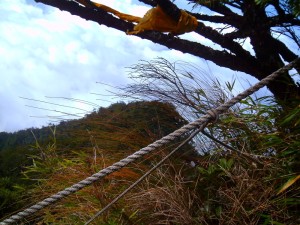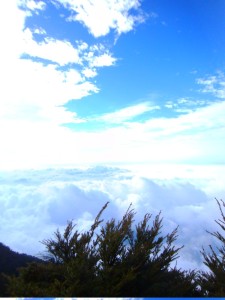As I said in the introduction, this whole series is an exercise in connecting the dots.
That’s not to say I have done an exhaustive job. Far from it. I did not write anything about geology, for example. If I were to go into discussing everything connected to Beidawushan, I could keep this series running forever. The point is to make a deep enough scratch in the surface to get a glimpse of what lies below, or more accurately, to weave together some threads of knowledge to form an increasingly strong web.
This is the process of holistic learning. To quote Olle Linge:
“Holistic” might sound like a fancy word for some people, but it’s actually quite simple. Rather than focusing on single, separate units of data or facts, an holistic approach regards everything as a part of something, as part of the whole. Everything you learn will be connected to everything else you know, perhaps not directly, but at least via other bits and pieces of knowledge you have stored in your brain. A multidimensional web is the most accurate metaphor for this kind of structure.
This series was prompted by my departure from Taiwan. I completed and scheduled all of this posts before I left, but most of them were published after I was already gone. I want to hold onto my memories of Taiwan, and one way to do that is to put them together into a learning web so that when I think of one thing, it will bring to mind another thing.
You might think I chose Beidawushan because is my favorite place in Taiwan, or at least because it is very special. It is not. There are places in Taiwan more beautiful and fascinating than Beidawushan. Beidawushan has its unique features, but I chose it as a topic, not because it is exceptional, but because it is typical.
And as I said in the introduction, one of the most important things I have taken with me is an improved ability to learn holistically. I am a better learner now than when I came to Taiwan.
This type of learning is sorely lacking in formal education, both in Taiwan and in California. That’s not to say it is totally absent – some professional educators do try to foster holistic learning. But lots of formal education on both sides of the Pacific is highly focused on cramming facts into one’s head to pass a test set out by authorities, facts which will be promptly forgotten after finals. Students spend an incredible amount of time studying for exams when, in fact, if they want to get high scores they should stop studying.
Yet holistic learning is not just about becoming a better student. It’s about thinking about whole systems rather than isolated compartments. And a lack of systematic thinking cuts through the heart of the great crises of our time.
People fail so badly at managing environmental crises when they cannot think about the whole system. Take climate change, for example:
– Some people think that their consumption of fossil fuels are limited to simply the gas they put in their vehicles and the electric bills their pay, totally ignoring, for example, the fossil fuels need to produce frozen dinner they bought that day.
– Some people only look at carbon emissions, which might cause them to, say, ignore methane emissions, such as the methane emissions from factory-farm cattle or rice paddies.
– People who are only looking at climate change might ignore the fact that the earth is losing about 1% of its topsoil every year, the effects of nuclear waste, the collapse of fish populations around the world due to greedy fisheries, the prevalence of toxic chemicals in stuff sold to ordinary people, the destructive impacts of damming rivers … and this list could go on, and on, and on.
– Some people treat the environment as a issue that can be kept separate from social problems. It cannot. For example, why have fossil fuel companies devastated indigenous communities from Canada to Ecuador with toxic spills, and why are governments pushing policies which will continue the devastation? You can’t explain that without understanding finance (where do these companies get the funds to pollute the environment?) or colonialism and racism.

I think some people who suggest dealing with climate change by going to higher altitudes do not understand just how harsh higher altitudes can be.
When discussing the documentary Beyond Beauty: Taiwan from Above, some Taiwanese people said that the public will fix the problems described in the film. I was skeptical, not because I doubt the good intentions of the public, but because Taiwanese people pour so much time and energy into cramming their studies, working overtime to keep a job, or escaping through games/TV/social media/manga/movies, that I’m not sure how they’ll get the time/energy to understand the problems, let alone act. Hikers obviously have a bit of time and energy … and many hikers already understood the issues described and were harsh critics of government and business policies even before the film came out.
El Palo Alto, which is Spanish for ‘The Tall Tree’, is the name of a famous redwood tree, not unlike the famous red cypress tree on the Beidawushan national trail (indeed, once we reached the red cypress forest, I started yapping about coast redwood trees in California). Two entire towns, Palo Alto and East Palo Alto, are named after this single tree. Palo Alto home of famous institutions such as Stanford University and Hewlett-Packard, and has been home to famous people such as Steve Jobs and Jeremy Lin. East Palo Alto is home to poor people, many of whom are Latino or black, who find it very difficult to escape poverty because there are few jobs, many cannot afford cars, and public transit is terrible. In college I knew someone living in East Palo Alto who did not have a car, so he had to either a) spend 2-3 hours each way riding buses to go to class or b) ask people who did have cars (few of whom lived in East Palo Alto) to give him rides – additionally, he worked part time to support his himself. On top of this, East Palo Alto has one of the highest homicide rates in California – I once overheard someone say ‘I live in Menlo Park. People live in Menlo Park. People die in East Palo Alto’.
Anyway, about El Palo Alto. California is currently working on building a high-speed train, which means that the train tracks which pass right by the tree will need to be expanded. This might damage the tree. Thus, local citizens have organized to protect the tree from the high-speed train project.
Someone pointed out that the area is so developed that the conditions which allowed El Palo Alto to grow so high no longer exist, thus El Palo Alto will have no successor when it dies (even coast redwoods are not immortal). The high speed train, on the other hand, might prevent additional road construction in California, or kill the intra-California flight industry (much as the high-speed train in Taiwan killed the Taipei-Kaohsiung flight route) which will help preserve old growth forests where redwoods can support a vibrant ecosystem.
I don’t completely agree with the commentator’s analysis, but at least he was thinking about forests, while some people were only able to think about a single tree.
In order to reduce the harm that contemporary civilization causes to our environment – and, you know, try to prevent billions of people from dying horrible deaths at young ages – we need to think more about the forest, and not just about the tree. And we need to think about the rivers which come from the forest, the farms which depend on the rivers, the people who depend on the farms, what the river brings into the ocean, and the mountain which collects moisture from the ocean and pulls it back into the forest.
And we need to stop thinking about nature as something separate from humanity – humanity is part of nature. That’s why I spend so much time discussing the humans of Beidawushan. Ecology, culture, economics, politics, geology – it’s all connected. For example, the Archdruid Report has some thought-provoking essays about religion and nature here, here and here.
For another example, hiking is a popular recreational activity in Taiwan. Hiking Beidawushan usually means riding a fossil-fuel powered vehicle to the trailhead – where the great typhoon Morakot landslide is. Burning that fossil fuel contributes to increasing the intensity and frequency of Morakot-like storms.
One of the inspirations for this series is the piece “WHAT THE FLUCK”. It’s about a totally difficult topic, but I admire Adam Curtis’ ability to weave private equity firms, Philip K. Dick, high-heel shoes, elections for a coal-miners union, a former mayor of Minneapolis, a British sex icon from the 1950s, Standard Oil, an editor who had just been fired from his job, small farmers on the prairie, drug addiction, and kittens all into a cohesive narrative.
If you liked the individual bits of this blog series – the photos, the myths, the practical hiking information – that’s nice. But what I really hope people will take away from “The Beidawushan Series” is a sense that everything is connected, and that readers will become a little better at understanding how everything is part of a whole.

To the extent possible under law,
the person who associated CC0
with this work has waived all copyright and related or neighboring
rights to this work.









Pingback: The Beidawushan Series: The Hikers | The Notes Which Do Not Fit